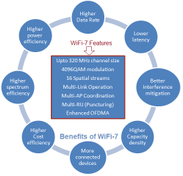
Understanding Zigbee RF4CE: Radio Frequency for Consumer Electronics
Explore Zigbee RF4CE, a standard for RF remote controls in consumer devices. Learn about its features, frame structure, and comparison with other wireless technologies.
Showing 20 posts (Page 9 of 10)
Advertisement

Explore Zigbee RF4CE, a standard for RF remote controls in consumer devices. Learn about its features, frame structure, and comparison with other wireless technologies.
Explore UPB technology for home automation in IoT. Learn about its reliability, cost-effectiveness, addressing, and compatibility compared to X10.
Prepare for UWB job interviews with these common questions and detailed answers. Learn about UWB features, applications, and technology.

This page compares UWB and Enocean, highlighting their differences in data rate, frequency, bandwidth, modulation, range, and applications.

Explore the differences between UWB and GPS technologies in terms of accuracy, range, data rate, security, and applications for positioning and tracking.

Explore the differences between UWB and RFID technologies, covering standards, frequencies, data rates, accuracy, security, and applications.

Compare Ultra-Wideband (UWB) and WiFi technologies based on standards, frequency, accuracy, range, data rates, security, and other critical parameters.

Explore the key differences between UWB and Insteon technologies, focusing on their data rates, physical layers, frequencies, and applications.

Explore the differences between UWB and Wavenis technologies. Compare frequency, data rates, range, security, and applications to understand their strengths.

Explore the pros and cons of Ultra-Wideband (UWB) technology, including its benefits like low power consumption and high data rates, as well as drawbacks like higher cost and potential interference.
Explore Wavenis wireless technology: its ultra-low power consumption, long-range capabilities, and applications in M2M, IoT, and smart grids.

Explore the differences between Wi-SUN and WiFi technologies, including standards, data rates, coverage, and applications in smart homes and cities.
Explore the key differences between WiBro and Mobile WiMAX technologies, including FFT sizes, MIMO support, HARQ schemes, duplexing methods, and network architectures.

Explore the differences between WiFi 4 (802.11n) and WiFi 5 (802.11ac), including speed, range, bandwidth, and other parameters.

Explore the key differences between WiFi 6 and WiFi 7, including data rates, frequency bands, modulation, MIMO, and channel size.

Explore the key differences between WiFi 6E and WiFi 7, focusing on their performance, bandwidth, and suitability for various applications.

Explore the pros and cons of WiFi 6E, an extension of WiFi 6 using the 6 GHz band, offering faster speeds, lower latency, and improved performance.

Explore leading WiFi 7 SoC chipset manufacturers driving 802.11be standard. Discover innovations for ultra-fast, low-latency wireless connectivity.
Explore the pros and cons of WiFi sensing technology, including its privacy benefits and limitations in accuracy and environmental sensitivity.
Explore the key differences between WiFi and Bluetooth technologies, focusing on data rates, power consumption, range, and typical applications.
Advertisement